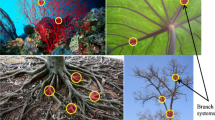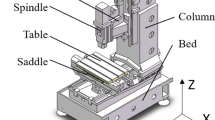Abstract
Highly stiff and lightweight machine tool structures are very important for improving machining accuracy. How to reasonably arrange stiffeners is one of the problems that designers must solve to achieve required structural performances. This paper presents a practical approach for stiffener layout design, which is inspired by the adaptive growth phenomenon observed in nature. Firstly, a mathematical model is built to provide theoretical basis for the adaptive growth of stiffeners to the applied load. Then a corresponding algorithm is developed to realize the generation of stiffener layout, during which the growth rates are determined by the generalized heights of stiffeners and the growth directions by branching and degenerating operations. When applying the approach to redesign an actual machine tool bed structure, a simple spring model is introduced, which can greatly reduce computation cost by transforming the 3D stiffener layout design problem into a 2D one. Numerical and experimental results show the stiffness enhancement, and thus, the applicability and validity of the approach are proved.
Similar content being viewed by others
References
Chandrasekaran M, Muralidhar M, Murali Krishna C, Dixit US (2010) Application of soft computing techniques in machining performance prediction and optimization: a literature review. Int J Adv Manuf Technol 46:445–464
Özel T, Hsu TK, Zeren E (2005) Effects of cutting edge geometry, work piece hardness, feed rate and cutting speed on surface roughness and forces in finish turning of hardened AISI H13 steel. Int J Adv Manuf Technol 25:262–269
Pahk HJ, Lee SW (2002) Thermal error measurement and real time compensation system for the CNC machine tools incorporating the spindle thermal error and the feed axis thermal error. Int J Adv Manuf Technol 20:487–494
BendsØe MP, Kikuchi N (1988) Generating optimal topologies in structural design using a homogenization method. Comput Methods Appl Mech 71:197–224
Krog LA, Olhoff N (1999) Optimum topology and reinforcement design of disk and plate structures with multiple stiffness and eigenfrequency objectives. Comput Struct 72:535–563
Luo J, Gea HC (2003) Optimal stiffener design for interior sound reduction using a topology optimization based approach. J Vib Acoust 125:267–273
BendsØe MP (1989) Optimal shape design as a material distribution problem. Struct Optim 1:193–202
Chung J, Lee K (1997) Optimal design of rib structures using the topology optimization technique. P I Mech Eng C-J Mech 211:425–437
Pedersen NL (2000) Maximization of eigenvalues using topology optimization. Struct Multidiscip Optim 20:2–11
Xie YM, Steven GP (1993) A simple evolutionary procedure for structural optimization. Comput Struct 49:885–896
Yang XY, Xie YM (1999) Bidirectional evolutionary method for stiffness optimization. AIAA J 37:1483–1488
Huang X, Xie YM (2011) Evolutionary topology optimization of continuum structures including design-dependent self-weight loads. Finite Elem Anal Des 47:942–948
Liu SH, Ye WH, Lou PH, Tang DB, Huang JG (2012) Structural dynamic optimization for carriage of gantry machining center using orthogonal experimental design and response surface method. J Chin Soc Mech Eng 33(3):211–217
Akla W, El-Sabbagha A, Bazb A (2008) Optimization of the static and dynamic characteristics of plates with iso-grid stiffeners. Finite Elem Anal Des 44:513–523
Mattheck C, Burkhardt S (1990) A new method of structural shape optimization based on biological growth. Int J Fatigue 12:185–190
Steele CR (2000) Shell stability related to pattern formation in plants. J Appl Mech-T ASME 67:237–247
Liu WY, Hou WF, Ou YX (2007) Relationship between medial axis pattern of plant leaf and mechanics self-adaptability (I): experimental investigation and numerical simulation. J South China Univ Technol 35:42–46
Ding X, Yamazaki K (2004) Stiffener layout design for plate structures by growing and branching tree model (application to vibration-proof design). Struct Multidiscip Optim 26:99–110
Li YX, Xue K (2011) Mechanics in leaf venation morphogenesis and their biomimetic inspiration to construct a 2-dimensional reinforcement layout model. J Biomimetics Biomater Tissue Eng 10:81–93
Boudaoud A (2010) An introduction to the mechanics of morphogenesis for plant biologists. Trends Plant Sci 778:1–8
Li BT, Hong J, Yan SN, Liu ZF (2013) Multidiscipline topology optimization of stiffened plate/shell structures inspired by growth mechanisms of leaf veins in nature. Math Probl Eng 2013:1–11
Wei P, Ma HT, Chen TC, Wang MY (2010) Stiffness spreading method for layout optimization of truss structures. The 6th China-Japan-Korea Joint Symposium on Optimization of Structural and Mechanical Systems, Kyoto, Japan
Xu T (1995) The application of similarity method. China Machine Press, Beijing
Author information
Authors and Affiliations
Corresponding author
Rights and permissions
About this article
Cite this article
Yan, S., Li, B. & Hong, J. Bionic design and verification of high-precision machine tool structures. Int J Adv Manuf Technol 81, 73–85 (2015). https://doi.org/10.1007/s00170-015-7155-6
Received:
Accepted:
Published:
Issue Date:
DOI: https://doi.org/10.1007/s00170-015-7155-6




